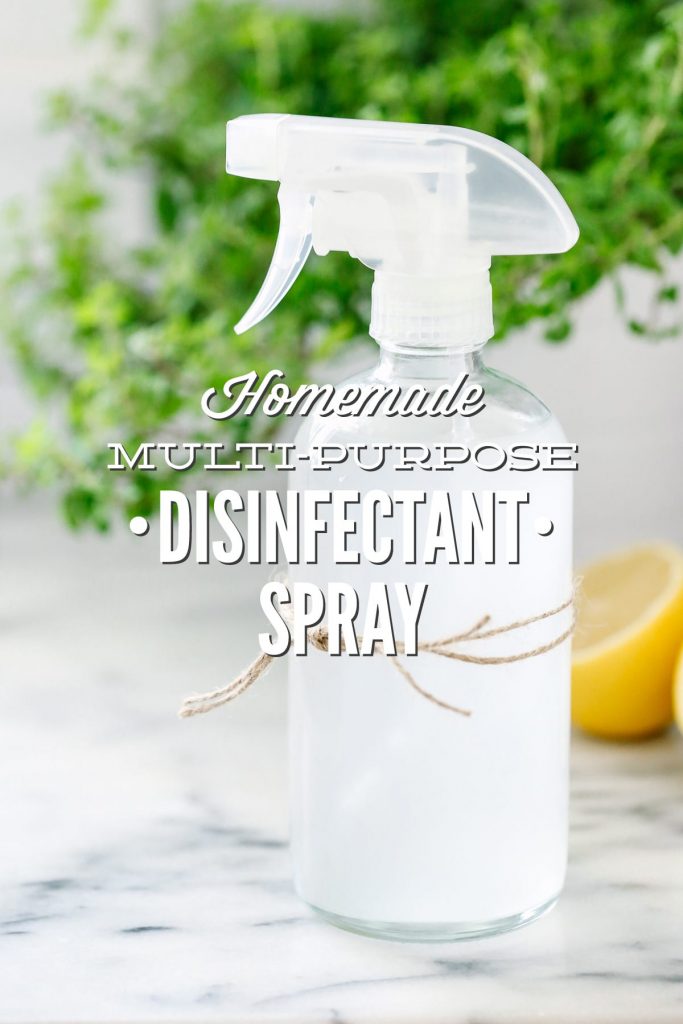
Want to Save This Article?
Enter your email & I’ll send it straight to your inbox. And you’ll get new recipes & tips each week.
Two weeks ago, Mrs. Sniffles knocked on our “door.” I tried to convince her to leave with my homemade remedies, but she insisted on staying, so for the last two weeks we’ve been battling an unwelcome guest and nasty sinus infections.
Mrs. Sniffles was sure to pack every “present” for her extended stay, too: runny nose, sore throat, tiredness, etc. Thankfully, after lots of rest, vitamin C, sore throat tea, elderberry syrup shots, and elderberry soda, Mrs. Sniffles finally decided to pack-up her remaining luggage and move on. Hallelujah! It’s wonderful to have energy and a clear head again.
As it turns out, our family isn’t the only family who’s been affected by Mrs. Sniffles. She’s quite the experienced traveler! The entire school district in Pinellas County (where we live) has been hit hard by her visits. Some schools have seen dramatic decreases in weekly attendance since January.
Right now is the perfect time to start talking about (and using) a light disinfectant spray. Or shall I say a replacement for the stuff found on store shelves? I’m sure most of us have vivid memories of heavily-perfumed sprays due to their popular use in restaurant bathrooms, homes, and even classrooms.
Just the other day I noticed a store-bought spray and its infamous, headache-inducing scent in the women’s bathroom at Dustin’s work. Honestly, I don’t blame his work (or others) for using a store-bought spray, because marketing would lead me to believe that a store-bought solution, full of mystery ingredients, is the only way to properly clean and disinfect a room. Personally, I never once thought about what was in those sprays before our real food conversion, or even thought that a simple alternative may be sitting in my pantry or medicine cabinet.
Alcohol may be used for much more than a strong cocktail. It’s also a very handy DIY ingredient, as well as vinegar and particular essential oils.
Disinfecting is an activity that’s (generally) done after cleaning and, in my cleaning opinion, needs to be done much less often in the average home. “Disinfecting…refers to killing a high percentage of the germs on a surface or rendering them incapable of reproducing.” (source)
Disinfecting takes care of more than just dirt, grease, or dust. I don’t believe disinfecting every surface on a regular basis is essential in a modern-day home, thanks to indoor plumbing and healthy hygiene practices. Now when Mrs. Sniffles comes knocking, or I cut raw meat on my favorite cutting board, I’m all about using a homemade disinfectant spray. PS: I share my preferred approach for disinfecting a cutting board at the bottom of my recipe.
And that, my friend, is exactly why I mixed up a bottle of my simple 3-ingredient homemade spray this past week. Take that Mrs. Sniffles!
More Natural Ways to Protect Against Unwanted Germs
- Homemade Hand Sanitizer Spray: A simple spray for when you need to wash your hands and don’t have soap and water.
- Homemade Hand Sanitizer Gel: Want a gel instead of a spray? This recipe is for you.
- Natural Ways to Boost the Immune System: My tried-and-true ways to naturally maintain a healthy and happy immune system.
- Homemade Elderberry Syrup: A homemade remedy that’s delicious and beneficial.
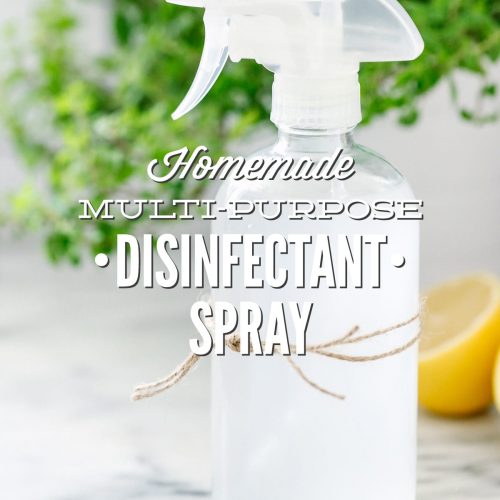
Homemade Multi-Purpose Disinfectant Spray
Ingredients
- 1 1/2 cups 100 proof alcohol (vodka) or higher get the highest proof alcohol you can find (in some states you can buy 190 proof, which is Everclear, if not at least 100 proof) or at least 70% isopropyl rubbing alcohol. Rubbing alcohol can damage painted and varnished surfaces so it's best to spot test first.*
- 1/2 cup white distilled vinegar or more alcohol
- 50-60 drops tea tree essential oil or lavender essential oil (optional)
Instructions
- Pour the vodka into a 16 ounce spray bottle and then the essential oil(s). Shake the bottle to combine the vodka and oils. Finally, add the vinegar and shake the bottle again. This recipe is not safe to use on special stone surfaces, like granite or marble, due to the vinegar. Please see the notes section below for more information.
- I've also used a Bandit Oil (Thieve's Oil or Germ Destroyer) blend in my spray instead of the tea tree essential oil. Learn more about the science behind using essential oils for disinfecting.
Notes
Disclaimer: The DIY recipes on this website are based on my personal experiences. I am not a trained chemist, cleaning specialist, or skincare expert. The DIY recipes shared on this website haven’t been tested in a lab. Information about my products or recipes haven’t been evaluated by the Food and Drug Administration. This information is not intended to diagnose, treat, cure, or prevent any disease. Please consult a doctor or specialist for specific concerns about any skincare issues, cleaning products, or dietary needs. Please use your discretion, based on your own research, when making homemade products.

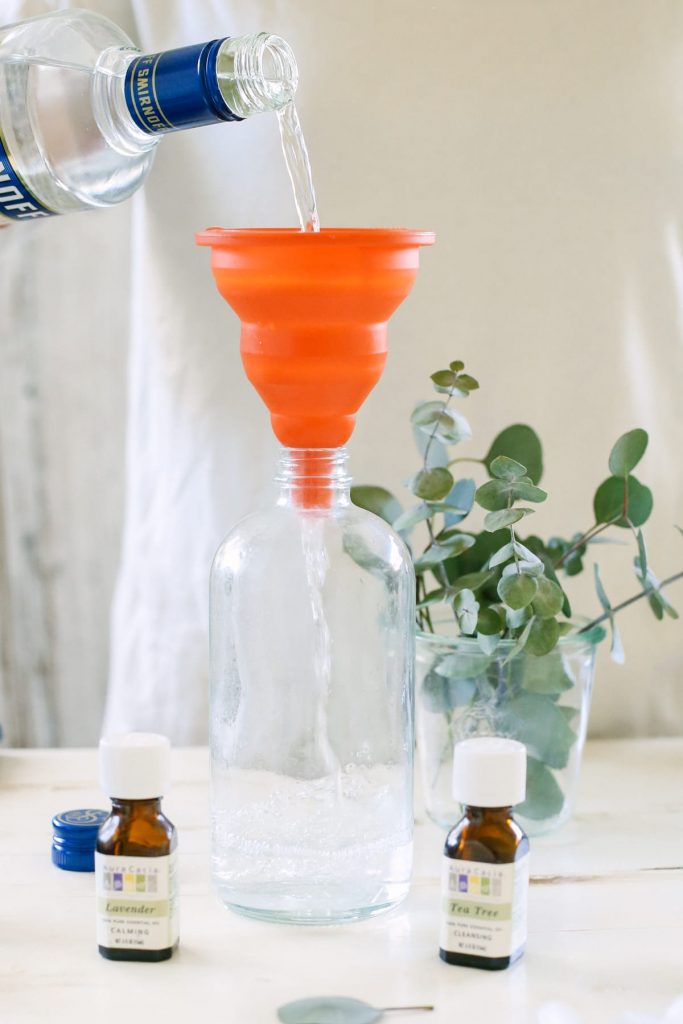
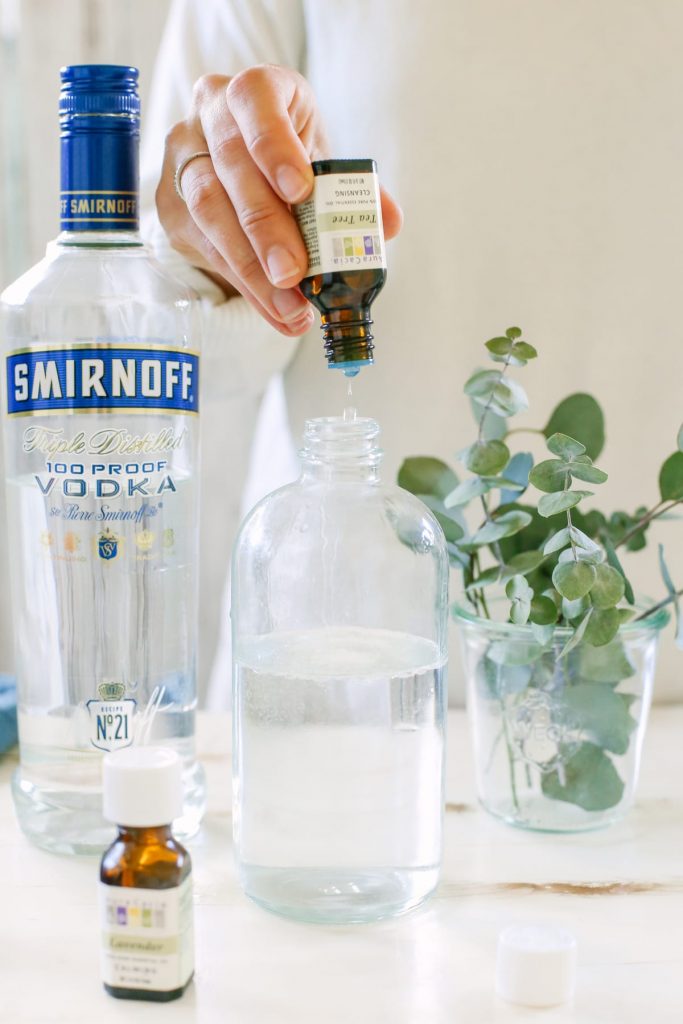
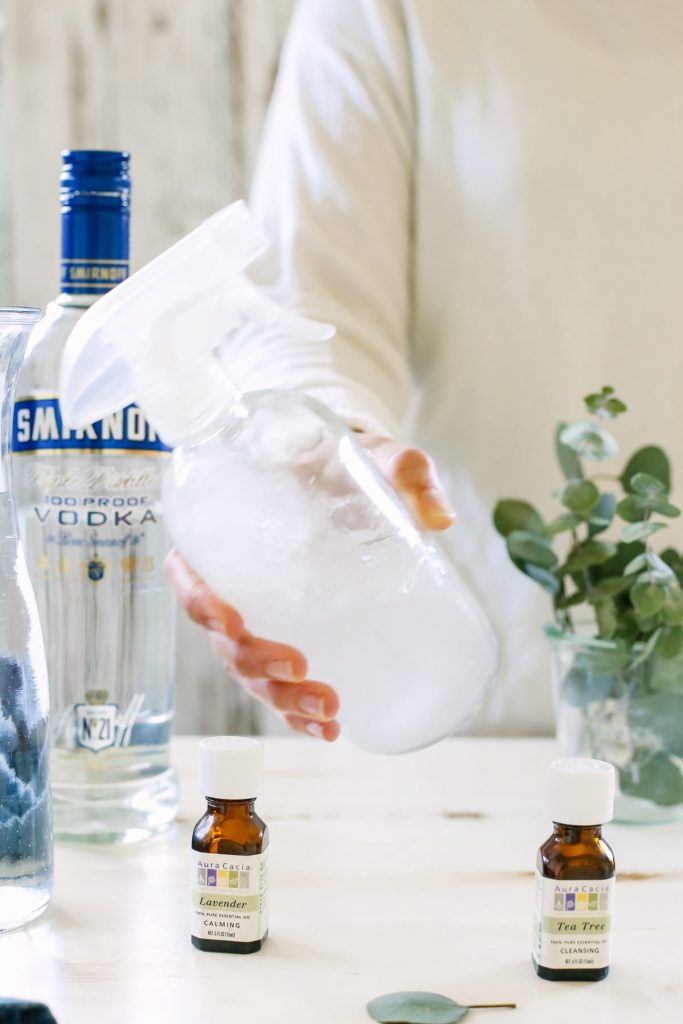
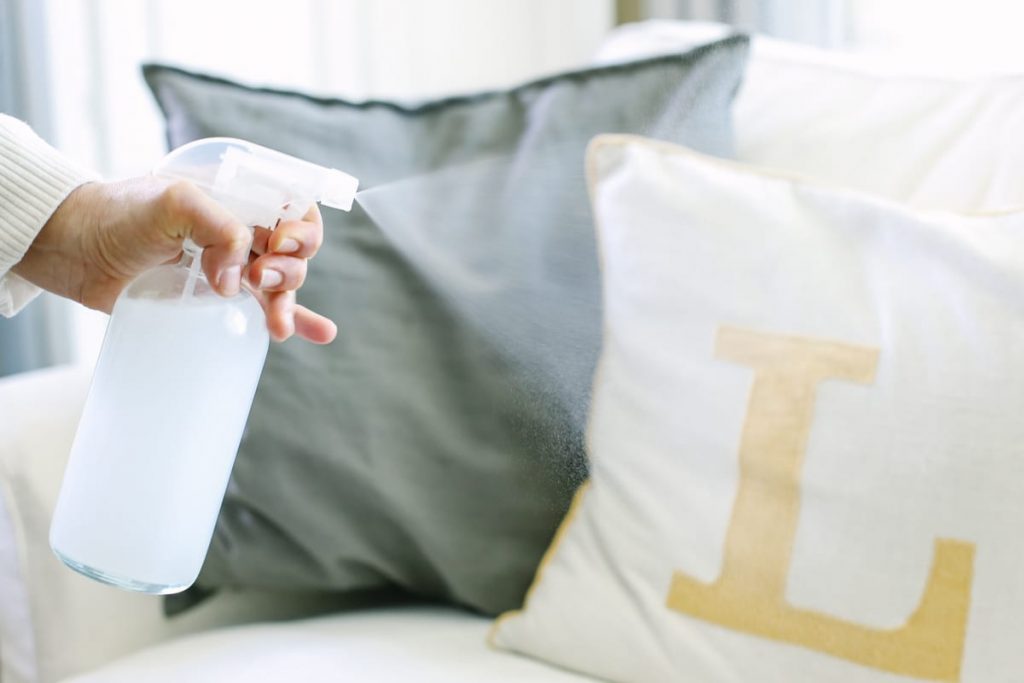
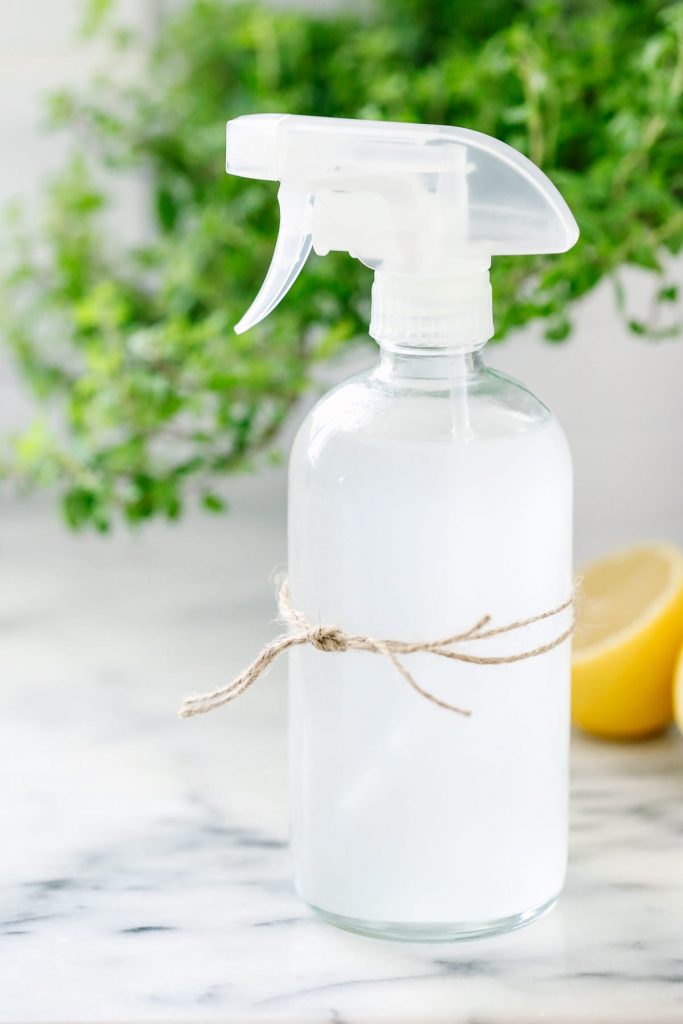
I forgot, I also wanted to address a question posted by someone else re: using just vinegar, water, and the essential oil… Mixing the essential oil with vodka (or other alcohol) before adding the other fluids keeps the essential oil suspended in solution instead of separating and floating on top. Anytime I use essential oils in my homemade cleaners, I ALWAYS mix them with cheap vodka or rubbing alcohol before adding the rest of the ingredients. This prevents you from having to shake the bottle every three seconds, and ensures that each spritz has the same ratio of ingredients.
Definitely, Laurie.
Great recipe, thank you! I did want to alert folks that many essential oils are toxic to cats, including tea tree/melaleuca, lavender, peppermint, thyme, and others. Please do your research before using essential oils in places where cats can touch or even inhale them. I have discovered that rosemary essential oil is both an excellent disinfectant AND is safe for cats.
Thanks, Laura. I’m glad you enjoyed it. Yes, we recommend everyone be informed and well researched when using essential oils.
What are your thoughts for using this as a surface spray on, leave on to air dry disinfectant for an in-home child care situation? Like to spray on toys and surfaces after the children leave for the day? My other question is would this discolor wood surfaces? We have mostly wood toys in my home-based preschool program. Thank you! The childcare centers I always worked in used a bleach/water solution for this purpose but didn’t have many wooden toys and in addition my home is bleach-free and we use only natural, essential oil based cleaners.
My two cents, outdoormama… I think this would be fine as a leave-on spray. It would just take a bit longer to dry than conventional Lysol. You could try using rubbing alcohol instead of vodka, and/or increasing the ratio of whichever alcohol you do choose to use since alcohol evaporates faster than water or vinegar. I use rubbing alcohol in my homemade window cleaner for just this reason. Bear in mind, though, that increasing the alcohol content might damage the finish on the wooden toys… Test in an inconspicuous area or on a less valuable toy
hello Kristin, read in reviews that disinfectant can be made by just Vinegar and Tea Tree oil.
So below works?
1/2 cup white distilled vinegar
3/4 cup water
50-60 drops tea tree essential oil or lavender essential oil
I like half water and half vinegar and the tea tree, or 100% vinegar is always option for a surface that’s not delicate.
Hi Kristen, I am wondering why the vinegar was added ? Are you saying the alcohol and tea tree alone does not disinfect? I’m only asking as I liked to used this on my counter tops intermittently and I have read that vinegar is not safe for granite. Thank you.
Hey Craig, The alcohol and tea tree work great for that purpose (and most purposes, in my opinion). Always test a small area first before using it on stone or delicate surfaces. I added the vinegar for tougher disinfecting jobs which some folks felt tea tree and alcohol may not be enough for.
Wear do I purchase tree oil?
Hi Maxine,
Any health food store should have tea tree oil.
LS Team.
Okay, thank you. Unfortunately, my kids HATE when I clean with vinegar.
Does this smell like vinegar?
Hey Alicia, Yes, it will have a slight vinegar scent. The scent goes away after a few minutes.
What was it that made you include vinegar? I’m searching for the perfect disinfectant recipe and am a little confused about the battle for best disinfectant, vinegar vs vodka…
Hey Eerika, Vinegar is known to be an excellent cleaner and disinfectant.
What are the pros and cons between using vodka vs. using vinegar though? How do they compare?
Hey Lo, From my research, vinegar is less controversial as far as it’s disinfectant properties. There’s more studies to support the use of vinegar in this role.
Hi Kristin, I am wondering do i use a cup of white vinegar for the recipe if I do not have high proof vodka? I just started my diy natural journey and I’m so glad that I found your website! 🙂
Hey Kay, Yes, that’s what I would do :). That will work well. Welcome to Live Simply!
Has anyone tested this to see what germs are killed? I bought the ingredients today, but my kids have the flu and strep. I’m trying to avoid bleaching the whole house, but I’ve gotta kill the germs.
Hey Alice, I’m sorry to hear they’ve been sick. I can only speak to what I would do in my own home…
In that particular scenario, I’d personally use 100% vinegar with tea tree, and also wash everything with HOT soapy water. I personally would use the strongest vinegar solution possible and also air out my home (opening windows and doors, if possible).
Here’s some info: http://www.rodalesorganiclife.com/home/natural-disinfectant and http://mbio.asm.org/content/5/2/e00013-14.full
And here’s info about alcohol uses: https://www.cdc.gov/hicpac/disinfection_sterilization/6_0disinfection.html
Very easy to follow the recipe. Well explained.
The product has come out very good, smells fine and I use it always to disinfect areas which need to be.
Thank you, Miriam.
So glad I found this! I can’t wait to use this in my home!
You should remove this post. Alcohol needs to be at least 60% for disinfection, that is why they sell rubbing alcohol starting at 70%.
Telling people to dilute vodka, which is only 40% alcohol to begin with, and use it for disinfection is bad advice. Even if your readers notice that you are using high proof vodka (which is not really Vodka any more, as Vodka, by definition is 40% alcohol), that is still not nearly strong enough for disinfection, as your “high proof vodka” is only 50% alcohol. Your mixture might make some pillows smell nice, but it is not wise to recommend people use it for fighting germs.
Thank you for sharing, Brian! There are two mixtures used in the formula: 1. alcohol (or vinegar) 2. tea tree oil.
I’m confused, so which vodkas/alcohols are actually going to be effective in this recipe? Unclear about your answer to Brian also. And if we sub out the alcohol with vinegar, that means 1 whole cup of white distilled vinegar?
Hey Lo, Yes, you can use 1 cup of vinegar, or even 100% vinegar depending on the surface you’re spraying. Rubbing alcohol is considered the most effective to my knowledge and reading on the CDC, but many people don’t like using rubbing alcohol when it comes to spraying something in the home. I definitely encourage you to read more about both on the CDC website. The recipe is what I use, so reading up on the ingredients (and studies) is highly encouraged.
Can I also add a few in-wash scent boosters?
Hey Jazzybell, Can you explain what in-wash scent boosters are? Thanks!
Can you use this as a fabric disinfectant/refresher, like Febreeze, or do you have another recipe for fabric?
Hey AJ, You could definitely use this as a fabric refresher!
I’m starting to get into homemade products like this-can I use this on wood floors?
Hey Gina, Awesome! I recommend staying away from vinegar and alcohol when cleaning hardwood. This is my recommendation: https://livesimply.me/2016/04/30/homemade-floor-cleaner-multi-surface/.
Lovely recipe! I love homemade things and eco-friendly solutions! This multipurpose spray will be perfect for me. It come at a right time for me because the spring cleaning is about to start very soon. Thanks for sharing!
Thanks, Juana. Enjoy!
Kristen,
Can I use this on granite counter tops?
Hey Ruth, Yes, it should be safe. I recommend decreasing the ratio to 50:50 water and alcohol, just to be safe. Also, spot-test first.
NO! Vinegar is an acid; it will degrade the countertops. Always use a granite-safe cleaner!
Thanks, Stephanie! I’m glad you commented. The original recipe didn’t include vinegar. And that’s when we had this convo. Going to make sure people are aware that this comment was directed to the recipe without vinegar.
Can this also be used as a spray hand disinfectant?
Hey Mrsc, The vodka may be harsh on the hands (drying). Here’s my hand sanitizer recipe: https://livesimply.me/2014/09/17/diy-hand-sanitizer/.
Could you substitute the vodka with rubbing alcohol?
Hey Lisa, Yes, you can. The only caution is that the odor will be very strong! I would also recommend reducing the amount to a 50/50 concentration versus the current recipe.
Hi! Can this be used on carpet?
Hey Jane, Based on my experience, yes it can :).